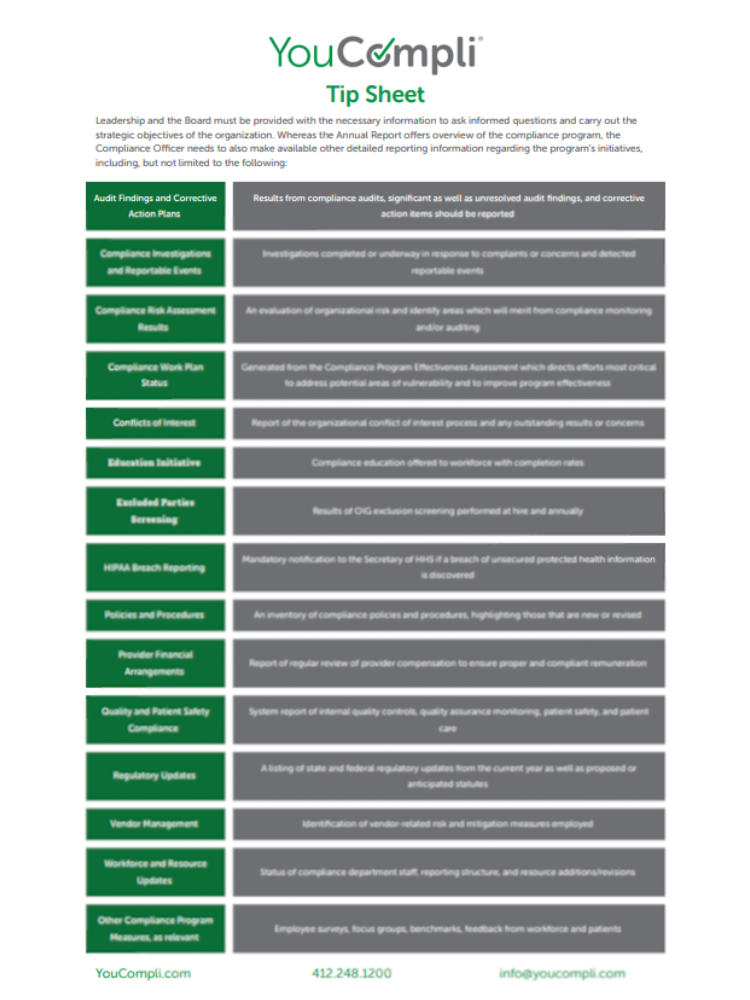
In a football game, the Fourth Quarter can be the defining moment for either the team defending its lead, or the team trying to come back and reverse its fortune. The team that has put forth effective play action, efficient clock management, and tight teamwork looks forward to the Fourth Quarter to maintain possession of the ball and run the clock down. Conversely, for the team that is trailing on the scoreboard, the Fourth Quarter demands regrouping and, often, making significant changes to the game plan. While the game objective remains the same for either team – i.e., score more points than the opponent – each team’s approach will depend on their position when entering the Fourth Quarter.
Similar to a football coach, a Compliance Officer is accountable to the organizational leadership and Board for the effectiveness of the compliance program. This accountability is dependent on accurate data which can be compiled and reported successfully – and which enables the coach to assess the team’s status and plan the best path forward to victory. As the Fourth Quarter approaches, compliance program initiatives must be evaluated before the “final whistle” at the end of the year.
Typically, the coach and key team players provide a wrap-up at a post-game news conference, answering questions and providing insight regarding the team’s plays and the outcome of the game. Similarly, one of the key Fourth Quarter responsibilities for the Compliance Officer is producing the Annual State of the Compliance Program Report (Annual Report). This general overview of the compliance program provides valuable insight into the organization’s compliance with applicable laws, regulations, other industry standards, and any identified control weakness areas with compliance risk. This is one of the most important duties that a Compliance Officer performs. Like the post-game wrap-up, the Annual Report is intended to provide insight and demonstrate the outcomes of the compliance program, as opposed to presenting tedious results consisting of technical numbers and statistics.

A valuable Annual Report will demonstrate credible outcome evidence of the compliance program’s progress and improvement, and enhancement planned for the next year. The Annual Report not only provides the results of the organizational compliance efforts, but also highlights opportunities for program improvement and planned actions to enhance effectiveness.
Leadership and the Board must be provided with the necessary information to ask informed questions and carry out the strategic objectives of the organization. Whereas the Annual Report offers overview of the compliance program, the Compliance Officer needs to also make available other detailed reporting information regarding the program’s initiatives, including, but not limited to the following:
| Audit Findings and Corrective Action Plans | Results from compliance audits, significant as well as unresolved audit findings, and corrective action items should be reported |
| Compliance Investigations and Reportable Events | Investigations completed or underway in response to complaints or concerns and detected reportable events |
| Compliance Risk Assessment Results | An evaluation of organizational risk and identify areas which will merit from compliance monitoring and/or auditing |
| Compliance Work Plan Status | Generated from the Compliance Program Effectiveness Assessment which directs efforts most critical to address potential areas of vulnerability and to improve program effectiveness |
| Conflicts of Interest | Report of the organizational conflict of interest process and any outstanding results or concerns |
| Education Initiative | Compliance education offered to workforce with completion rates |
| Excluded Parties Screening | Results of OIG exclusion screening performed at hire and annually |
| HIPAA Breach Reporting | Mandatory notification to the Secretary of HHS if a breach of unsecured protected health information is discovered |
| Policies and Procedures | An inventory of compliance policies and procedures, highlighting those that are new or revised |
| Provider Financial Arrangements | Report of regular review of provider compensation to ensure proper and compliant remuneration |
| Quality and Patient Safety Compliance | System report of internal quality controls, quality assurance monitoring, patient safety, and patient care |
| Regulatory Updates | A listing of state and federal regulatory updates from the current year as well as proposed or anticipated statutes |
| Vendor Management | Identification of vendor-related risk and mitigation measures employed |
| Workforce and Resource Updates | Status of compliance department staff, reporting structure, and resource additions/revisions |
| Other Compliance Program Measures, as relevant | Employee surveys, focus groups, benchmarks, feedback from workforce and patients |
Like winning football teams, effective compliance programs demonstrate value.
Flourishing, successful teams produce tremendous fan satisfaction, as well as revenue for the stakeholders and the community. High-quality compliance programs provide protection for the organization against untoward consequences of non-compliance and contribute to quality patient care as well as financial success for the organization.
As we get underway in the Fourth Quarter, both football coaches and Compliance Officers must be prepared to take inventory, assess progress, and report the results to demonstrate positive outcomes. As both the coach and the Compliance Officer look to the future, this Fourth Quarter review will not only reveal what they have accomplished, but what opportunities lie ahead.
Susan is a healthcare compliance leader with over four decades working in a variety of administrative and managerial capacities, including strategic planning, regulatory oversight, revenue cycle risk mitigation, denial and appeal management, privacy and information security, healthcare advocacy, clinical department leadership, provider practice administration, risk management, and quality outcomes. Currently, Susan provides compliance and privacy consulting services to a variety of healthcare organizations, including program implementation, policy and procedure development, compliance and privacy training, and regulatory oversight administration.
Susan is a Certified Internal Auditor (CIA), Certified Healthcare Compliance (CHC), Certified Professional Coder (CPC) and holds a Certification in Risk Management (CRMA).

Download a PDF Version of the Table

Download our Latest White Paper

Qualified compliance professionals do the heavy lifting for you, simplifying regulatory change management
Our in-house team works tirelessly to monitor U.S. regulators, carefully read the regulations in their entirety, and translate the information into simple regulatory intelligence you can use. We deliver model procedures and expert tools that can be used to fulfill your business requirements. Everything is validated by a third-party law firm.

